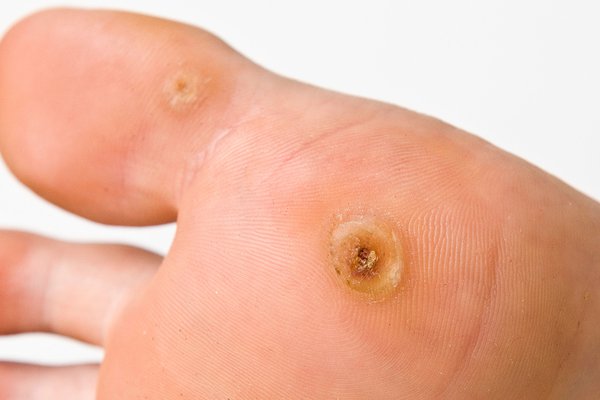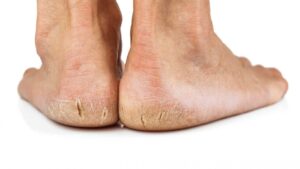Verrucas, also known as plantar warts, are a common skin condition. They typically appear on the soles of the feet, causing discomfort and often confusion.
What exactly is a verruca? How does it form and what does it look like?
These are some of the questions that individuals dealing with this condition often ask.
In this article, we aim to provide comprehensive answers to these queries. We’ll delve into the causes, symptoms, and treatment options for verrucas.
Whether you suspect you have a verruca or are simply curious about this skin condition, this guide will provide useful insights.
What is a Verruca?
A verruca is a type of wart that typically forms on the soles of the feet. It’s caused by the human papillomavirus (HPV), a common virus that can infect the skin.
Verrucas are often hard and grainy, with a rough surface that may resemble a cauliflower. They can appear flat due to the pressure exerted on them when walking. Despite their often unsightly appearance, verrucas are generally harmless but can cause discomfort and pain, especially when standing or walking.
The Verruca Lifecycle: From Appearance to Resolution
Verrucas can appear suddenly, often developing on the pressure points of the foot. They start as small, rough patches of skin, gradually growing in size and becoming more noticeable. The presence of tiny black dots, which are clotted blood vessels, is a common characteristic of verrucas.
Over time, verrucas may change in appearance. They can become discolored, often turning grey or brown. This is a sign that the verruca is dying and the body’s immune system is successfully fighting the virus.
Despite their stubborn nature, most verrucas will eventually disappear on their own. This can take anywhere from a few months to a couple of years, depending on the individual’s immune response.
Causes of Verrucas: The Role of HPV
Verrucas are caused by certain strains of the human papillomavirus (HPV). This virus infects the outer layer of the skin, causing a rapid growth of cells that results in a verruca.
HPV is highly contagious and can be easily transmitted through direct skin-to-skin contact. It can also spread indirectly through contact with contaminated surfaces, such as the floors of communal showers or swimming pools.
Despite the contagious nature of HPV, not everyone who comes into contact with the virus will develop a verruca. Factors such as the strength of the immune system and the condition of the skin can influence susceptibility.
Identifying Verrucas: Symptoms and Visual Signs
Verrucas often appear as small, hard, grainy growths on the soles of the feet. They may have a rough surface that looks like a cauliflower, and a pattern of tiny black dots. These dots are actually small, clotted blood vessels.
Verrucas can be painful or tender when you walk or stand. However, they can also be asymptomatic, causing no discomfort at all.
Here are some common signs of a verruca:
- A small, grainy skin growth on the foot
- A rough, cauliflower-like texture
- Tiny black dots within the growth
- Pain or tenderness when walking or standing
Who is at Risk? Understanding Verruca Vulnerability
Verrucas can affect anyone, but some people are more susceptible than others. Children and teenagers, for instance, are more likely to develop verrucas due to their active lifestyles and frequent use of communal areas.
People with weakened immune systems are also at a higher risk. This is because their bodies may struggle to fight off the human papillomavirus (HPV), which is responsible for causing verrucas.
Verruca Treatment: Home Remedies and Over-the-Counter Options
There are several ways to treat verrucas at home. One common method is using salicylic acid, which is available over the counter. This treatment works by breaking down the thick layer of skin that forms the verruca.
Another option is using a pumice stone or foot file to gently remove the top layer of the verruca. This should be done carefully to avoid damaging the surrounding skin.
Here are some tips for home treatment:
- Always follow the instructions on the product packaging.
- Protect the skin around the verruca with petroleum jelly before applying treatment.
- Be consistent with treatment application for the best results.
Remember, while home remedies can be effective, they may take several weeks to work. If your verruca is causing significant discomfort or spreading, it may be time to seek professional treatment.
When to Seek Professional Verruca Treatment
While many verrucas can be treated at home, there are times when professional help is needed. If your verruca is causing significant pain, spreading to other areas, or has not improved with home treatment, it’s time to see a doctor.
Additionally, individuals with weakened immune systems or certain medical conditions should seek professional treatment. Remember, early intervention can prevent complications and speed up the healing process.
Professional Verruca Treatments: From Cryotherapy to Surgery
Professional treatments for verrucas are diverse and effective. One common method is cryotherapy, where a Podiatrist applies liquid nitrogen to freeze and kill the verruca cells. This treatment may require several sessions to fully remove the verruca.
Another option is laser therapy, which uses concentrated light to destroy the verruca. This method is often reserved for stubborn verrucas that have not responded to other treatments.
In some cases, surgical removal may be necessary. This involves cutting out the verruca under local anesthesia. It’s important to note that this method may leave a scar and is typically a last resort.
The least invasive and most natural way to remove plantar warts is via Marigold Therapy. The treatment is painless, quick acting and does not have adverse effects. It is suitable for people in ‘at risk’ categories for whom surgery is contra-indicated, and people of all ages including children.
Preventing Verrucas: Practical Tips and Foot Hygiene
Preventing verrucas is largely about maintaining good foot hygiene. This includes keeping your feet clean and dry, as verrucas thrive in moist environments.
Avoid walking barefoot in communal areas like swimming pools or locker rooms. These places are often breeding grounds for the HPV virus that causes verrucas.
Here are some practical tips to help prevent verrucas:
- Wear flip-flops or pool shoes in communal areas.
- Don’t share towels, socks, or shoes with others.
- Regularly change your socks and ensure your shoes are dry.
- Check your feet regularly for signs of verrucas.
The Psychological Impact of Verrucas and Support Available
Verrucas can have a psychological impact, causing embarrassment or distress. This is especially true if they are visible or cause discomfort when walking.
Support is available for those affected. Many online forums and communities offer advice and share experiences. Don’t hesitate to seek help if you’re feeling overwhelmed.
Conclusion: Managing Expectations and Recurrence
Verrucas can be stubborn, and recurrence is common. It’s important to manage expectations and understand that treatment may take time.
Remember, maintaining good foot hygiene and following treatment instructions can help manage verrucas effectively. Stay patient and persistent in your treatment efforts.










